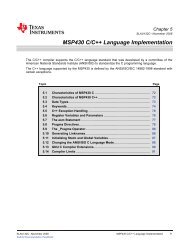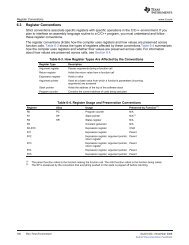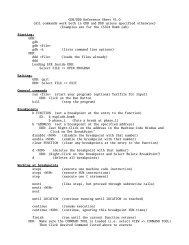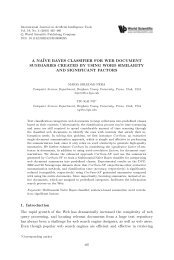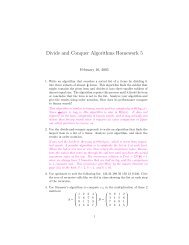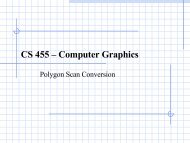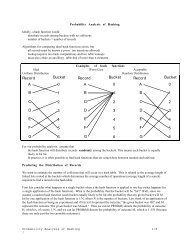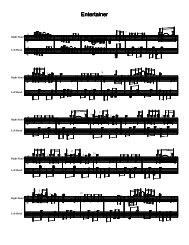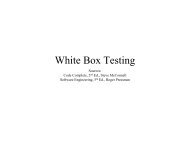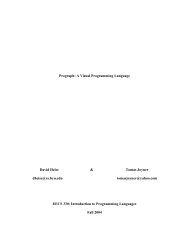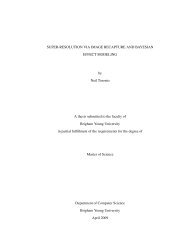Approximate Implicitization Using Monoid Curves and Surfaces
Approximate Implicitization Using Monoid Curves and Surfaces
Approximate Implicitization Using Monoid Curves and Surfaces
You also want an ePaper? Increase the reach of your titles
YUMPU automatically turns print PDFs into web optimized ePapers that Google loves.
Written in triangular Bernstein-Bezier form, it looks like this:<br />
with<br />
0<br />
B<br />
@<br />
s<br />
t<br />
u<br />
v<br />
1<br />
C<br />
A =<br />
P<br />
P<br />
i+j+k=n<br />
i+j+k=n<br />
,<br />
w ijk Q n<br />
<br />
ijk ijk i j k<br />
w ijk<br />
, n<br />
ijk<br />
the weights w ijk = c ijk0 , ic i,1;j;k;1 , jc i;j,1;k;1 , kc i;j;k,1;1<br />
<strong>and</strong> the control points Q ijk =<br />
0<br />
B<br />
@<br />
<br />
i j k (40)<br />
,ic i,1;j;k;1<br />
1<br />
C<br />
A =w ijk:<br />
c i;j;k;0<br />
,jci;j,1;k;1<br />
,kci;j;k,1;1<br />
Similarly, the coecients c ijkl satisfy the \same-sign" condition if the weights w ijk are all non-negative orall<br />
non-positive, <strong>and</strong> the weights at the three corners are nonzero.<br />
4.2 <strong>Approximate</strong> implicitization <strong>and</strong> inversion map<br />
We now consider approximate implicitization for a rational Bezier surface of degree n k with control points<br />
P ij <strong>and</strong> weights ! ij :<br />
p(; ) =<br />
nP kP<br />
i=0 j=0<br />
nP<br />
i=0 j=0<br />
! ij P ij B n i ()Bk j ()<br />
kP<br />
! ij B n i ()Bk j () ; ; 2 [0; 1]: (41)<br />
In general, the implicit degree of p(; ) is 2mk. An approximate monoid surface q() = 0 for this implicit<br />
equation can be found using the following procedure.<br />
1. Determine the reference tetrahedron for the monoid surface.<br />
A method for nding the optimum tetrahedron that ensures maximum numerical stability <strong>and</strong> the best<br />
accuracy remains to be discovered. As of now, we are able to propose only an intuitive way of constructing<br />
the reference tetrahedron, a direct extension of the approach we used to determine the reference triangle<br />
for a curve. Namely, for a given rational parametric Bezier patch, we compute an oriented bounding box<br />
<strong>and</strong> nd the \concave" side of the patch. The multiple point is chosen on that side. The other three<br />
vertices are determined on the base plane of the bounding box such that the tetrahedron contains the box.<br />
Since the construction is similar to that for curves, we omit further details.<br />
2. Convert the parametric surface p(; ) into barycentric form.<br />
18




